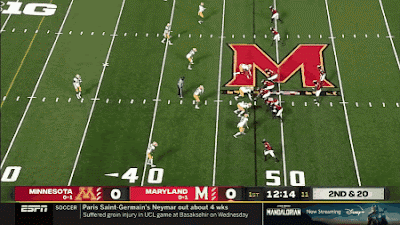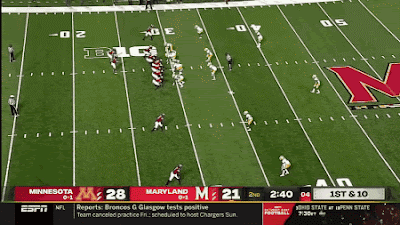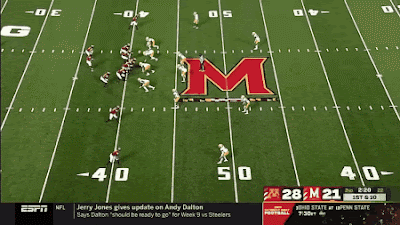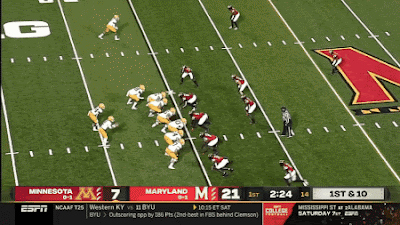The Gophers' opener hinted that their defense would be a bigger problem than anticipated. Their second game indicated that it might be bad enough to wreck their season. Against a team that scored just three points in their first game, the Gophers' defense wasted a strong offensive performance by allowing 10.2 yards per play in a 44-45 overtime loss to hapless Maryland. It was a catastrophe that potentially forebodes more catastrophe, and it demands a postmortem.
1. Minnesota's run defense had its worst day in two years.
On November 3, 2018, Minnesota visited Illinois. Explosive runs had been a problem for defensive coordinator Robb Smith's unit. While the Illini couldn't throw the ball, they had perhaps the Big Ten's most explosive running back in Reggie Corbin. It was a matchup doomed from the beginning; Corbin ran for 213 of the Illini's 435 non-sack rushing yards, and as a team, Illinois averaged 27.3 Highlight Yards per carry.
Smith was fired immediately after Minnesota's 55-31 loss; Joe Rossi replaced him on an initially interim basis and brought the defense to respectability, saving the Gophers' season and earning the coordinator job permanently. Between the time Rossi took over and the end of the 2019 season, Minnesota allowed 6 or more yards per carry just twice.
After the departure of several regulars, the start of Minnesota's 2020 brought unwelcome reminders of Smith's tenure. Michigan averaged 9.3 yards per carry. But against a far weaker Maryland team, that seemed sure to change. Aside from a good first drive, the Terrapins looked totally inept in their opener at Northwestern. The Gophers' defense might not look excellent when they visited College Park, one might have thought, but it would at least look a decent bit better.
Such an optimistic outlook did not prove true.
For the analytically inclined, here is what a night full of the above looks like in numbers:
 |
| You can find explanations for each stat here. Line Yards and Success Rate are via api.collegefootballdata.com |
It was bad. Maryland found success attacking the edge, exploiting an area of weakness that Michigan had the week prior. Their ends and linebackers were too slow, couldn't beat their blockers, and didn't maintain their gaps, and the safeties took bad angles. In the below play, M.J. Anderson took too long to shed the left tackle and couldn't set the edge, Cody Lindenberg didn't recognize the pulling blocks quickly enough to get wide, and Jordan Howden gave up a few more yards at the end by just not making enough of an effort to tackle.
Here, Lindenberg did his job fitting the front side on a read option, but Boye Mafe crept too far up the line while watching the mesh point for the quarterback to not keep the ball.
On the game-tying touchdown in the fourth quarter, the pulling center easily sealed off Lindenberg, and Howden was following the slot receiver in coverage. Mariani Sori-Marin was too slow to make up for it, and based on the angle Tyler Nubin took, he either thought he was much faster than he is or totally misjudged the direction of the run.
There were missed tackles, too. Keonte Schad (who caused a fumble near the goal line for which Micah Dew-Treadway got credit) almost took advantage of being left unblocked on the below buck sweep by making a tackle for loss, but the defensive tackle wasn't quick enough to get more than his fingers on Jake Funk. Mafe overran Funk and made as much contact as Schad did.
Lindenberg had one of the worst whiffs of the night on this handoff:
The last two weeks of dreadful performances have not been the fault of one player, nor have they been the result of one kind of error repeating itself. Everyone needs to improve, and everything needs work.
2. As Joe Milton did the week before, Taulia Tagovailoa ran well against the Gophers.
In 2020, Minnesota is allowing 9.6 yards per carry to quarterbacks. That won't hold over a full season, but over two games, it's certainly alarming. Tagovailoa gained 75 yards on the ground Friday night. Some of it was on designed runs.
 |
| Watch Sori-Marin and Nubin both fall for Tagovailoa taking one step to his left. |
And much of it was on scrambles, including his longest run of the night, this 39-yard touchdown. It came after a shallow rush by Sori-Marin left him in a bad position when Tagovailoa was flushed from the pocket. Neither he nor Thomas Rush were fast enough to catch up.
Fortunately, there aren't many especially mobile quarterbacks left on Minnesota's schedule. But the big issues that led to these successful runs — poor gap discipline, bad angles, and missed tackles — aren't inherent to defending quarterback runs and don't typically fix themselves quickly.
3. It was a terrible day for the Minnesota pass defense as well.
Maryland took advantage of a young defense and man coverage by frequently running pick plays. That included their first touchdown, which was initially flagged for pass interference but declared legal because Funk caught the ball behind the line of scrimmage.
It was an easy way to pick up a 1st down in short-yardage situations, like on this 3rd-and-3:
But Maryland also found their way into the flat without setting picks. Take this 3rd-and-4 call, which appeared intended for the stick route on the right, but Rakim Jarrett was left open on the outside when Jeshaun Jones' slant took the cornerback defending him into the linebacker in the middle:
 |
| Jones should have been called for a block in the back, by the way. |
The boundary corner in the above play was the one to blame for this gain, as the Gophers were in zone, and he was the flat defender. That is Benjamin St-Juste, who became a reliable player for Minnesota last season but was also responsible for one of the game's worst breakdowns:
St-Juste lost inside leverage to Jones, and then when Jones made the catch and ran into traffic, St-Juste just stopped. Sixty yards later, it was a touchdown.
But he wasn't the only defensive back to not make plays. Here's Terell Smith missing a tackle in space while in St-Juste's place, with Jordan Howden arriving too late to clean up:
Without dealing with significant pressure, meanwhile, Tagovailoa was far more effective than in his Terrapins debut. Here's a perfect throw on a seam route that negated good coverage from Coney Durr:
Unlike against Northwestern, Tagovailoa was accurate when throwing on the run. In the case of this throw, he was right on the money, which was not easy:
On the night, Tagovailoa threw for 394 yards and three touchdowns, posting the 10th-best Raw QBR of Week 9. Minnesota's pass defense was a major strength last year and was supposed to be reliable again in 2020, but through two games, it's allowed 10.3 yards per attempt.
4. Neither P.J. Fleck nor Mike Locksley coached aggressively enough.
I'm still trying to figure out how in the second quarter Locksley determined that after converting a 4th-and-1 from Minnesota's 48-yard line, attempting to convert a 4th-and-2 from Minnesota's 43-yard line was just too great a risk. A score on that drive would have given Maryland the lead back, and there was ample time to make up for a turnover on downs.
But the most confusing stretch of conservative coaching came late in regulation. With a lead, Fleck tried to slowly choke the game away rather than quickly kill it off. This didn't make much sense, considering the defense's consistent failures. (More on that later.) Then, once Maryland had tied the game, the Gophers mostly stayed on the ground and then punted on 4th-and-2 from roughly midfield, giving the Terps the ball and a chance to win the game with 1:12 remaining.
Maryland's drive stalled out, but on that 4th-and-2, they still had one chance for a Hail Mary or even an extra-long field goal attempt before overtime. Locksley had a timeout after Funk was tackled in Minnesota territory with 18 seconds left. He could have taken that timeout with a couple of seconds left and ran one more play; the worst-case scenario, a defensive touchdown, was far too remote a possibility to consider a serious risk. As the underdog, Locksley should have been more willing to get in one more shot because the longer the game went, the more likely it was that the better team would win.
You could also make the case that in overtime, each coach should have tried a two-point conversion after scoring a touchdown. Maybe Locksley doesn't have the job security to risk losing by coaching unconventionally, but if he had better than a 50-percent chance of getting the two points — and he probably did — he should have gone for it. The same goes for Fleck, perhaps moreso because of how impossible it is for him to lose his job. Each of them coached not to lose rather than to win.
5. Mohamed Ibrahim had one of the most impressive games of his career, largely thanks to a strong offensive line performance and effective scheme.
The last time Minnesota met Maryland, the Gophers ran for 324 yards. Friday, they ran for "only" 273 yards, and Ibrahim accounted for three-quarters of them. But unlike in the Michigan game, in which he had to work to reach the second level, Ibrahim found plenty of open space beyond the line of scrimmage.
Maryland's defense got a few important stops late in the game, but in general, Minnesota's offensive line avoided negative runs, created opportunities for big ones, and kept the offense on schedule.
A big reason for their success was their ability to attack the edge against a defense that had struggled to contain it against Northwestern the week prior. One way they did it was with plenty of outside zone:
This was meant to be inside zone, but Conner Olson created a cutback lane by outmuscling the end and taking out the cornerback who tried cheating into the A gap:
And two of Ibrahim's touchdowns were inside runs that he turned outside at the handoff, as Maryland had clogged the middle but without penetrating or setting the edge:
The Gophers didn't only run well outside the tackles (or tight ends), and Ibrahim wasn't the only player who performed; Treyson Potts added 45 yards, and Seth Green added a touchdown. It was a fantastic day on the ground.
6. That said, the Gophers' confidence in their run game, while not misplaced, was overinflated.
As excellent as the offensive line and Ibrahim were, there were limits to their effectiveness. No offensive line can consistently run into packed boxes. So when, needing a 1st down on what they hoped to be their game-winning drive, the Gophers saw a nine-man box, they should have checked out of the run.
Maryland stopped this play at the line of scrimmage.
But you don't have to look at that one play to question the Gophers' late-game approach. Ibrahim did his most damage before halftime, averaging 3.9 yards per carry in the second half, suggesting Maryland had adjusted. Guard Axel Ruschmeyer was injured midway through the game as well, weakening the line. Yet Tanner Morgan dropped back to pass on just a third of Minnesota's 30 plays in the second half, including on three of their 11 plays in the fourth quarter. (The Gophers' eight fourth-quarter runs gained 20 yards.)
Though the run game had worked well earlier, the Gophers shouldn't have assumed that they could mount the kind of marathonic drive they'd used to kill off games in the past, nor should they have believed their lead was bound to hold — especially when Maryland trimmed it to seven points. Against one of the nation's worst pass defenses, Minnesota should have tried to put the game out of reach with one of the nation's best passing offenses.
The coaches failed to either recognize or react to the fact they were in a shootout. And you don't win shootouts by holstering your biggest guns.
7. In a limited sample, Morgan was effective.
When the Gophers did throw the ball, Morgan justified it with a fine performance, reflected by the fact he averaged 12.6 yards per passing attempt and was sacked just once. He also finished the game with a rather bizarre-looking passing chart, as if the game was played without the left third of the field:
As he did plenty last season, Morgan found success throwing slants over the linebackers on RPOs. Maryland's large rotation of linebackers repeatedly came downhill at the first sign of a run, and Minnesota's receivers did well to break away from cornerbacks and to the inside.
If there was a reason for concern about the passing game (aside from its prominence), it was that Morgan only targeted four different receivers compared to the nine that got at least one target against Michigan. Still: That's a relatively minor issue, and it's worth noting that true freshman Daniel Jackson made his first catch as a Gopher.
8. When Rashod Bateman had another quiet game, Chris Autman-Bell made big plays.
Of Morgan's 31 throws against Michigan, just two were to Autman-Bell. Some week sooner or later, the Gophers' No. 2 receiver was going to play a bigger part in the passing game.
It turned out to be the very next week. Autman-Bell caught four passes on five targets, and he led all receivers with 112 yards. He also scored his first touchdown since the 2019 Penn State game, making an acrobatic catch over Maryland's Tarheeb Still and Jordan Mosley.
 |
| Against a team starting a true freshman corner, we should have seen a lot more of this. |
Most encouragingly, Autman-Bell produced in multiple ways, as shown on his touchdown and on the slant shown in the prior section. If the Gophers' offense is going to come close to last year's performance, they'll need their secondary weapons to both play well and offer different dimensions than Bateman presents.
9. Special teams, while improved from the first game, were lacking.
First the good: Regaining Michael Lantz allowed the Gophers to go long on kickoffs. Though Lantz didn't force any touchbacks, the longest return Minnesota allowed was 20 yards, and Maryland's average starting field position after kickoffs was 22.6 yards from their end zone. That is a major improvement from the Michigan game — a low bar to clear, but one that desperately needed clearing.
Now the bad:
- Brock Walker missed the game-tying extra point in overtime.
- Matthew Stephenson punted for nearly the same yards total he did against Michigan on the same number of attempts.
- Cam Wiley's three kick returns placed Minnesota at the 22-, 17- and 13-yard lines, resulting in his replacement. Going back to last year, he has averaged 17.9 yards per return on nine tries.
And finally some things to remember to temper one's angst and anger:
- Unless Walker starts missing extra points and short field goals, Gophers fans shouldn't be that worried. One attempt does not equal a trend. Of course, it's possible he misses more kicks because he's still not fully healthy after the sports hernia surgery that lowered his range on kickoffs.
- Stephenson isn't supposed to be the punter. Until Mark Crawford or Grant Ryerse can punt in Stephenson's stead, there's not much to be done except ask placekickers Lantz and Walker to try punting. And it's fair to assume that special teams coordinator Mark Wenger has either talked to them about that possibility or given them punting reps in practice, so if neither of them punt in a game, it's probably for a reason.
- If Wiley is done returning kicks, then at least the coaching staff will have identified a problem and made a necessary change to address it.
10. Preston Jelen has been one of Minnesota's brightest special teamers through two games.
In the first game, Jelen blocked a Michigan punt, picked it up, and then returned it 17 yards to set up a Gophers touchdown. In the second, he made three solo tackles on Maryland returns. Here is the second:
 |
| Potts also does well to cut through the middle and disrupt this return. |
On average, Jelen's tackles occurred at Maryland's 20-yard line; none crossed the 25-yard line. (Analytically speaking, a successful kick return is one that at least reaches the 25.) Do those three tackles amount to a major contribution? No, but it is significant enough to be noted. For a team with a bad defense, even a few yards of more favorable field position per game could be important. Jelen deserves credit for making plays.
Next Game
If Minnesota's defense is capable of having an alright day, it will likely have to come against Illinois. The Illini were hit hard by positive COVID-19 tests and contact tracing last week to the point that after an injury they were down to their fourth-string quarterback. Nine of the players who started against Wisconsin on either side of the ball didn't start against Purdue. Lovie Smith's team is severely shorthanded.
Quarterback Coran Taylor ran often but not always well against the Boilermakers (16 carries for 43 yards), but his passing was a pleasant surprise. He might be able to keep it up if Josh Imatorbhebhe can break through, having mostly been held in check this season. That said, Illinois saw contributions from elsewhere last week. Miami transfer Brian Hightower impressed with four catches for 97 yards and a touchdown. Tight end Daniel Barker has also featured significantly, totaling seven catches for 89 yards through two games.
Any offense might have a good day on the ground against the Gophers, but the Illini have been merely average in that respect so far. They didn't do much in Minneapolis season, and that was before Reggie Corbin graduated; Mike Epstein and Chase Brown haven't shown they can match Corbin's explosiveness so far.
When the Gophers had the ball in last year's game, the gameplan included lot of play-action:
Let's see if the Illini have gotten any better at defending against this:
I'll take that as a no.
Wisconsin and Purdue averaged 11.1 yards per pass attempt against the Illini. Minnesota's passing offense should be better than either of theirs. This should be easy.
The run defense has actually performed relatively admirably so far, allowing an average of 4.0 yards per carry. What linebackers Jake Hansen and Milo Eifler lack in coverage they bring in run support. I wouldn't recommend sticking to the run if the Illinois front seven doesn't show cracks early.
This is a team that Minnesota should score on easily. I feel confident in that, and so should the average viewer (assuming the week's "challenges" are not major). The obvious question, of course, is how many points they'll have to score. I don't think it will be in the 40s, but I also thought that going into the Maryland game. I expect the Gophers to win, perhaps even by double-digits, but the defense's performance may not alleviate fans' justifiably dispirited outlook.



























No comments:
Post a Comment
Note: Only a member of this blog may post a comment.